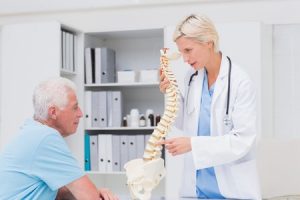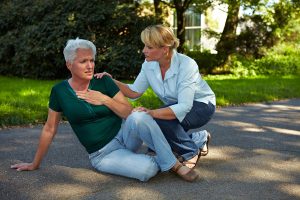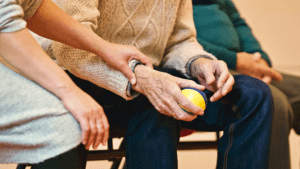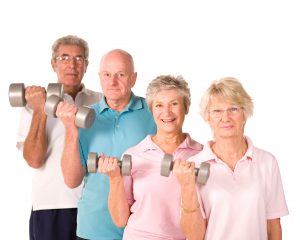Guest Blog: Seniors and Broken Bones: The Long Road to Recovery
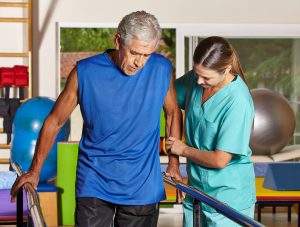
From a slight fracture to an arm to a full break in the shin or fractured hip, broken bones can be serious and result in months of therapy for recovery. When the injured person is a senior, the situation can be even more serious. They may be unable to remain in their own home and care for themselves, and in some cases, they are never able to return to their former level of independence.
Causes of Broken Bones
Falls are the main cause for broken bones in the elderly. They may also suffer a fracture due to a medical condition. It’s important to determine the cause so it can be prevented in the future and medical issues treated.
If the break occurs in either the legs or arms, hands or feet, the injury site may be placed in a cast and the limb immobilized. Some injuries are serious enough to require surgery. The patient may need pins or rods installed for the bones to stay in place until they heal.
Life After the Break
After the senior receives initial treatment for the break, the next step will to figure out care requirements. Depending on the location and severity of the break, the person may not be able to stay by themselves. They may have limited mobility and require assistance for daily tasks.
Even a minor break can sideline a senior more than someone younger. They may tire out easier, especially if the break requires them to move around on crutches.
An assisted living center is one option for seniors until their broken bones heal. Another option which might appeal more would be for them to hire an in-home caregiver. Even though family may want to help out, they have their own responsibilities. In certain situations, they may be able to be a paid family caregiver, which could ease the financial burden on the family and provide the assistance the senior needs until they’re back on their feet.
The Recovery Period
The senior will need to take certain steps to ensure their recovery is successful, and they can get back to their active lifestyle. This includes eating healthy, getting enough rest, and attending physical therapy and doctor appointments as recommended.
While enduring a broken bone for a senior can involve a lengthy recovery process, they can become independent once again with the right care.
Guest Post: Ways to Relieve Stress and Back Pain
Are you experiencing stiffness in your back? Beware; it might be an indication of stress. Though it might sound a bit weird, stress can cause back pains. Being anxious about anything switches on the stress response of your body. As a result, you become tenser as your body prepares you to fight, flee, or freeze in the stress causing situation. Your bloodstream is also flooded with a cascade of chemicals which in turn makes your muscles spasm. As a result, you experience back pain.
How To Reduce Stress And Back Pain?
After you know the reason for the back pain, it is important for you to take control of the stress levels. Here is a list of steps you can take to relieve stress level and the back pain generated from it.
Breathing and Stretching
Stretching can help you a great deal to make the stiffness of the back muscles go away. However, you should be very alert while stretching. Stop stretching if you experience any kind of pain. Deep breathing is a well-known technique which reduces stress. Pilates and yoga are also known to reduce stress and back pain. However, you should always consult a professional before you decide to take up these exercises.
Apply A Cold or Warm Compress
You can apply cold compresses such as ice pack if you have inflammation in your back. If your back is stiff, then you can use hot compresses such as a heating pad. Hot compresses also reduce muscle cramping and spasms. Therapists generally advise taking moist hot compress instead of dry one. To do that you can take a bath in hot water to loosen the sore muscles.
Avoid Caffeine
You should stop consuming caffeine at all. Caffeine increases the stress response in your body, which will prevent the healing of the back pain. You should go for caffeine-free alternatives such as lavender tea, which soothes the body and relieves stress.
Sleep
Sleep is most necessary to repair the sore muscles of your back. Most people who experience back pain also suffer from sleep disturbances which in turn induce stress. You should try different postures for better night’s sleep. Do not sleep on your stomach as this posture causes added strain to the back.
Exercise and Rest
Exercise is necessary to Relieve stress. However, too much exercise can increase back pain. If you do too little, then your muscles can become locked up resulting spasm. In short, you need to find a balance between these two. Regular walking and stretching can loosen and strengthen the back muscles.
Control of the stressors of life might not be in your hands, but maintaining your health is. So, practice these tips to not let the stressors interfere with the happiness of your life.
Considering a home emergency alerting system?
Reviews.com recently spent over 100 hours researching the medical alert system industry to help you choose the right product for you or your loved one. Bay Alarm may be the best choice when considering a home emergency alerting system, yet other systems also won praise for the services they provide.
Officially known as a personal emergency response system (PERS), an alerting device enables the elderly and those with physical disabilities to live independently and still be capable of seeking emergency assistance when needed. Such systems are invaluable when considering that one in three Americans aged 65 or older will experience at least one fall every year. In the event of a disabling injury, a PERS can turn a potentially fatal accident or illness into an event that is survivable.
Reviews.com medical alert systems study evaluates consumer products to determine the best in terms of both efficiency and cost. In this particular inquiry, Reviews.com examined 69 alerting devices. Ratings were based on a number of factors, including the services provided by the parent company. Reviews.com noted that PERS equipment is usually rented rather than purchased from the provider.
They also found wide gaps in the services that are available. In some cases, medical alert systems must be attached to a regular home security system. Some systems received low ratings due to their lack of mobility, while higher ratings were given to those that are easier to install and use or have certain features, including their ability to function even when submerged in water. Other options that were considered important included automatic fall detection and blood-pressure monitoring capability.
Bay Alarm Medical was given high marks for both its capabilities and the personalized service from the provider. Reviews.com concluded in its evaluation that Bay Alarm would be the most efficient in dealing with a medical emergency. Also receiving praise from Reviews.com was Medical Guardian alerting system and MobileHelp.
The Reviews.com evaluation noted the importance of PERS facilities, especially when considering the aging of the American population and the fact that many of these men and women prefer to continue living in their own homes, possibly alone.
You can see the full resource and find the right medical alert system for you or your loved one here: http://www.reviews.com/medical-alert-systems/
Why Companion Care is More Important than You Think
Many seniors admit that as they grow old, they prefer to settle down and stay rooted. Aging in place has its benefits, but some family members might be concerned about the state of their elderly loved ones in such cases. Concerns such as house chores, safety, and general isolation are a problem for these situations. In such cases, it may be time to consider companion care.
Companion care is a type of long-term care tailormade for seniors and tackles many of the challenges of living alone as an elderly person. Today, we’ll talk about the benefits provided by companion care, and why it’s so important for the elderly to have someone taking care of them.
Independence
A helping hand does not mean an elderly person becomes even more dependent. If anything, companionship actually enhances the feeling of independence. The fact is that as we grow old, we become less capable of doing self-sufficient activities such as driving or sports. Some family caregivers may also start losing their sense of freedom, as all their time becomes dedicated to their aging family.
A companion reduces all those worries. With a companion, the senior now has someone who can watch over them as they go about their daily life. They don’t have to be stuck at home because now, someone is around to watch them. Family caregivers also lessen their stress because they share the responsibility with a professional. In turn, this makes the elderly family member feel less guilty.
Strong social bonds ensure that an elderly individual continues to be happy and active, even in the twilight of their life.
Companionship
Unsurprisingly, something called companion care provides this benefit in spades. Social connections are important in raising the self-esteem of the elderly. A companion lets your senior loved one enjoy the big and small things with a friendly companion.
It’s a minor benefit to some, but people severely underestimate how much having someone with you improves one’s mental health. A companion assists your loved ones by teaching them important self-care rituals such as meditation, massage, and morning hygiene.
Validation
A lot of elderly people dread the fact that the world is passing them by. They operate under the false assumption that they are nothing but a burden, and for those suffering from diseases such as Alzheimer’s, this feeling is doubled in their moments of lucidity. The fear of being a burden only strengthens with every passing year.
A companion alleviates all those issues. In addition to helping the elderly’s quality of life, they also provide a comfortable presence for them. Depression in advanced age can be prevented by someone simply being in a home with the person. Companions communicating with your senior family member means they will always feel seen and heard.
For example, if a senior family member performs an accomplishment, such as succeeding at a difficult hobby or task, the companion is there to provide them with emotional support. Validation is a powerful thing because no person wants to feel alone.
Comfort
For the elderly, sudden change can be incredibly upsetting. Moving to a new place, their children leaving to start their own lives, and a plethora of other life stuff could be very detrimental to their mental state. Anxiety, fear, and depression are common for lonely senior citizens. Thus, most senior citizens prefer the comforts of settling down.
Companionship in a familiar place, such as a family home, leads to many benefits. Familiarity, comfort, and safety are only some of the benefits that come with staying in one place with a companion to care for them. Practically, it’s usually financially viable as there are no moving costs and also means they stay close to the friends they have made in the neighborhood.
Peace of Mind
Lots of family members may be concerned about leaving their elderly loved ones alone. Many senior adults do not like the idea that they make their children/younger family members feel “guilty” for leaving them. For the family who does choose to become caretakers, feelings of bitterness and depression may also ensue. Some cannot shoulder the anxiety of not having 100% of their time belong to them.
Hiring a companion fixes a lot of these issues. Some may balk at this idea as shoving responsibility of a loved one onto someone else, but that is simply untrue. Having your own free time is also important in caring for your loved one. They would not enjoy the idea of being your anchor (in the negative sense).
In addition, companions are trained exactly for this purpose. Certain things that you may struggle with are not a problem for a professional companion. They are trusted to give all of their focus to your loved one.
Conclusion
Companion care is a beneficial decision. The benefits above clearly outline why companion care should not be set aside as a “half-measure” in taking care of your elderly loved ones. Companions enhance your loved one’s life, and they are NOT a replacement for you. Make sure that you still visit your senior loved one regularly, and stay in contact with their companion for updates.
Guest Blog: Managing Back Pain as You Age
Like other critical parts of the musculoskeletal system, the spine experiences some wear and tear over the decades. Does this mean back pain is inevitable as you get older? Not necessarily.
What Happens to Your Spine as You Age?
The spine itself is composed of a series of stacked bones called vertebrae. Small joints between each vertebra allow for the spine’s range of movement and little rubbery discs with jelly-like centers inside make sure bones don’t rub against one another (they also serve as the spine’s shock absorbers).
Over time, these disks can dry out, shrink, and wear away, causing the spine to compress. This is known as degenerative disc disease. Sometimes the space surrounding the spinal cord will start to narrow too; this is known as spinal stenosis. Arthritis and osteoporosis may also affect the spine as you age leading to joint degradation and even spinal fractures.
Any of these age-related conditions can contribute to back pain, especially when bones start rubbing against one another and nerves get pinched. The body may even go as far as to grow bone spurs in an effort to stabilize a degenerating spine.
Preventing and Managing Back Pain
So, is there anything older adults can do to prevent it or at least manage the pain and discomfort that comes with those types of conditions? Definitely.
Experts recommend taking actions to relieve some of the burden your spine bears during daily activity. This includes:
- Exercising to strengthen your back and core to more properly support the spine
Practicing good posture when sitting, using the computer, texting, etc.
Wearing a back brace for added posture support and lumbar compression
Eating a healthy diet rich with anti-inflammatory foods that help you maintain a healthy weight and combat systemic inflammation in they body – think fresh fruits, vegetables, whole grains, nuts, seeds, legumes, and lean proteins
Reducing stress on the back. This may mean utilizing lumbar cushions when driving, updating your mattress to better support your spine when sleeping, and avoiding activities which exacerbate your back pain
Additional Thoughts
Of course, it is also important to remember that acute back pain can also stem from something as simple as a muscle strain. Lifting something heavy, straining your arms and neck reaching for something in an awkward position, even sitting for a long period of time in an uncomfortable chair – any of these things can cause back pain and inflammation.

